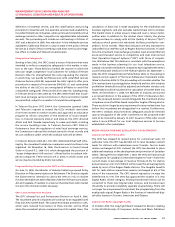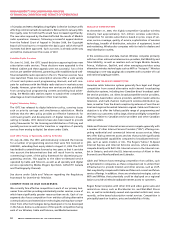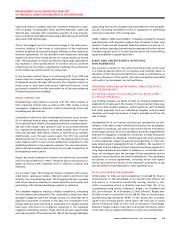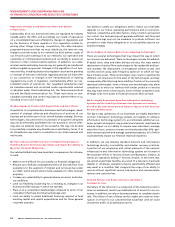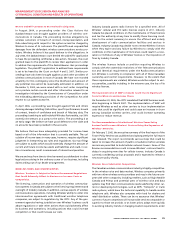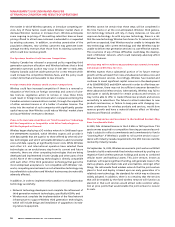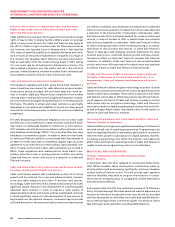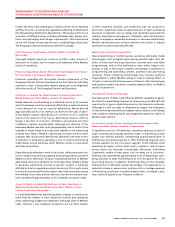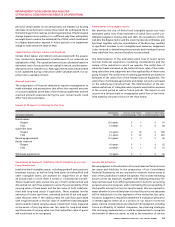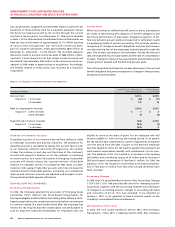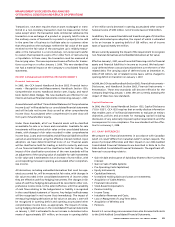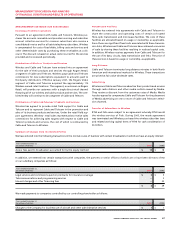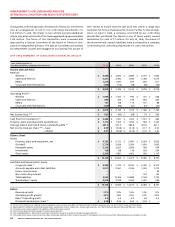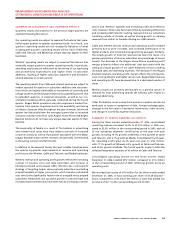Rogers 2006 Annual Report Download - page 63
Download and view the complete annual report
Please find page 63 of the 2006 Rogers annual report below. You can navigate through the pages in the report by either clicking on the pages listed below, or by using the keyword search tool below to find specific information within the annual report.
59
RO GER S CO MMU NIC AT ION S IN C . 20 0 6 ANN UA L RE POR T
MANAGEMENT’S DISCUSSION AND ANALYSIS
OF FINANCIAL CONDITION AND RESULTS OF OPERATIONS
In 2007, the CRTC is also planning to conduct a review of the Specialty
and Pay TV sector, as well as the regulations affecting all distributors
(the Broadcasting Distribution Regulations). This review will focus on
a number of different issues, including wholesale fees, dispute reso-
lution and packaging and linkage requirements. This broad-based
review will impact all specialty services, including Rogers Sportsnet,
The Biography Channel Canada and G4TechTV Canada.
Tarif f Increases Could Adversely Affect M edia’s Results of
Operations.
Copyright liability pressures continue to affect radio services. If
fees were to increase, such increases could adversely affect Media’s
results of operations.
Pressures Regarding Channel Placement Could Negatively Impact
the Tier Status of Certain of Media’s Channels.
Pressures regarding the favourable channel placement of The
Shopping Channel and Sportsnet below the first cable tier will likely
continue to exist. Unfavourable channel placement could negatively
affect the results of The Shopping Channel and Sportsnet.
A Decline in Demand for Advertising or Economic Downturns
Would Adversely Affect Media’s Results of Operations.
Media depends on advertising as a material source of its revenue
and its businesses would be adversely affected by a material decline
in the demand for local or national advertising. Media derived
approximately 44.6% of its revenues in 2006 from the sale of adver-
tising. Media expects advertising will continue to be a material
source of its revenue in the future. Advertising revenue, which is
largely a function of consumer confidence and general economic
conditions, remains unpredictable, although the diversity of the
businesses Media operates, both geographically and in terms of the
breadth of media, helps to provide some stability to the advertising
revenue base. Most of Media’s advertising contracts are short-term
contracts that can be terminated by the advertiser with little notice.
A reduction in advertising spending or loss of material advertising
relationships would adversely affect Media’s results of operations
and financial position.
Expenditures by advertisers tend to be cyclical, reflecting overall eco-
nomic conditions as well as budgeting and buying patterns outside of
Media’s control. Moreover, because a substantial portion of Media’s
advertising revenue is derived from local advertisers, Media’s ability
to generate advertising revenue in specific markets is adversely
affected by local or regional economic downturns. This is particularly
true in the concentrated Toronto market, where the combined revenue
from Media’s four radio stations and two over-the-air television sta-
tions represented approximately 12.5% of Media’s revenue in 2006.
A Loss in Media’s Leadership Position in Radio, Television or
Magazine Read ership Could Adversely Impact M edia’s Sales
Volumes and Advertising Rates.
It is well established that advertising dollars migrate to media prop-
erties that are leaders in their respective markets and categories
when advertising budgets are tightened. Although most of Media’s
radio, television and magazine properties are currently leaders
in their respective markets, such leadership may not continue in
the future. Advertisers base a substantial part of their purchasing
decisions on statistics such as ratings and readership generated by
industry associations and agencies. If Media’s radio and television
ratings or magazine readership levels were to decrease substantially,
Media’s advertising sales volumes and the rates which it charges
advertisers could be adversely affected.
Media Faces Increased Competition.
New programming or content services, as well as alternative media
technologies, such as digital radio services, satellite radio, DTH sat-
ellite, wireless and wired pay television, Internet radio and video
programming, and on-line publications have either begun com-
peting, or may in the future compete with Media’s properties for
programming and publishing content, audiences and advertising
revenues. These competing technologies may increase audience
fragmentation, reduce Media’s ratings or have an adverse effect on
its local or national advertising revenue. These or other technologies
and business models may have a material adverse effect on Media’s
results of operations.
Int roduction of New Technology.
The deployment of PVRs could influence Media’s capability to gener-
ate television advertising revenues as viewers are provided with the
opportunity to ignore advertising aired on the television networks.
Although it is still too early to determine its impact, the emergence
of subscriber-based satellite and digital radio products could change
radio audience listening habits and negatively impact the results of
Media’s radio stations.
An Increase in Paper Prices, Printing Costs or Postage Could
Adversely Affect Media’s Results of Operations.
A significant portion of Publishing’s operating expenses consists of
paper, printing and postage expenses. Paper is Publishing’s single
largest raw material expense, representing approximately 8.5% of
Publishing’s operating expenses in 2006. Publishing depends upon
outside suppliers for all of its paper supplies, holds relatively small
quantities of paper in stock itself, and is unable to control paper
prices, which can fluctuate considerably. Moreover, Publishing
is generally unable to pass paper cost increases on to customers.
Printing costs represented approximately 9.3% of Publishing’s oper-
ating expenses in 2006. Publishing relies on third parties for all of
its printing services. In addition, Publishing relies on the Canadian
Postal Service to distribute a large percentage of its publications. A
material increase in paper prices, printing costs or postage expenses
to Publishing could have a material adverse effect on Media’s busi-
ness, results of operations or financial condition.




